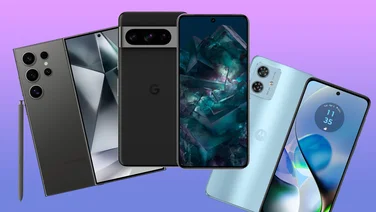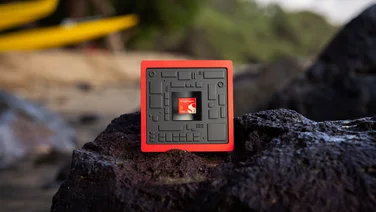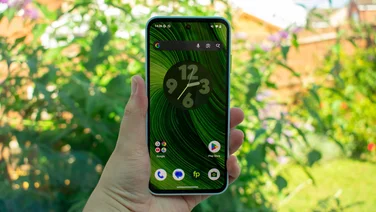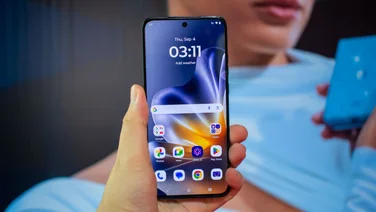To help us provide you with free impartial advice, we may earn a commission if you buy through links on our site. Learn more







- Not the Galaxy Fold
- Dual form factor
- Performs like a Samsung flagship
- Screen durability remains to be seen
- 5G upgrade costs more
There have been many pivotal moments in the history of the smartphone. The early success of Windows Mobile, the BlackBerry, the emergence of capacitive screens. The move away from keyboards to a full-screen touch interface with the original iPhone, which directly led to the shift from “it’s a clever phone” to “a do-anything mobile computing super-platform”. As such, the move to a phone that you can fold in half might not seem such a big deal.
But it is. Take the Z Flip to the pub, as I did before the virus hit, place it on the bar counter and open the screen. Conversation ceases. Eyes pop. “No way” is heard, along with “show me that again”. You show it folding and grown men squeal with delight. It takes a few moments to register that what has traditionally been a hard, inflexible screen, with a propensity to smash if you drop it on the floor, actually bends. And not just flex a little, but fold by 180 ̊.
However, this isn’t Samsung’s first bite at this particular bendy cherry, and last year’s folding tablet experience – the Samsung Galaxy Fold – left almost everything to be desired. A disastrous launch was soon followed by the product being pulled for sale, only to be released in a modified form many months later. It was better, but still reeked of being an alpha-release product. Is the Galaxy Z Flip just a beta model, or is it really ready for prime time?
Samsung Galaxy Z Flip review: What you need to know
Let’s start with the easy bits. While the Z Flip’s foldable screen is at the bleeding edge, the rest of its spec will leave your socks firmly on your feet. It uses a Snapdragon 855+ processor, with 8GB of RAM and 256GB of storage, of which some 36GB was in use. There’s no headphone jack, no microSD slot and it’s a single nano-SIM slot with the option of adding one eSIM. You might think that something this cutting edge would be 5G, but no – it’s resolutely 4G, although a 5G model is on the way.







To some observers, the lack of 5G signals a somewhat “last year” design approach, which contrasts with Samsung’s more cutting-edge technology on other devices. The Wi-Fi is limited to 802.11ac and not the more recent Wi-Fi 6 802.11ax standard (unlike the Apple 11 Pro). And note its eSIM support is limited to one eSIM, which is weaker than the Apple offering but might well be enough for most users.
The software is Android 10 with a full complement of Google apps, tools from Microsoft and the usual bundling of Samsung’s own apps. So you won’t be left struggling for icons to click on. Initial setup is easy, if somewhat complicated by the need to sign into Google and Samsung accounts, and you’ll go through an initial OS/firmware update. Then, in my case at least, there was a bunch of app updating to do. Yawn.
Once it’s up and running, you marvel at the screen – but we will come back to that in a moment.
READ NEXT: Samsung Galaxy S20 review
Samsung Galaxy Z Flip review: Design
Instead, let’s briefly focus on the other side of its form factor, which is a welcome change from the “brick in my hand” smartphones of recent vintage. When folded, the square aspect ratio is very usable and fits well into a small jeans pocket. When opened, it’s a petite-feeling tall and narrow screen that’s easy to use one-handed, provided it doesn’t slip out of your hand.
You can choose the usual boring black as a finish, but mine came in a funky shiny purple. This is a very distinctive look, but has an atrocious tendency to exhibit fingerprints and smears.







On the outside of the case, on the top side, is a tiny secondary screen. This shows the time, battery status and other useful things. It also shows the number or contact name when you have an incoming call. When such a call arrives, you flip open the phone to reveal the usual incoming call display. This action doesn’t automatically answer the call; you must still swipe on the green tick button. Pressing the power button on an incoming call stops the ringer and clears the micro screen, but doesn’t immediately push the call to voicemail. That requires waiting for the usual timeout. But at least you aren’t being bothered by the call any more. Incoming SMS messages are shown in the micro display too, scrolling if necessary. It’s discrete and works surprisingly well as a secondary information display.
Once you open the screen, you must get past security. You can use a PIN in the usual way, but there’s face recognition – and, to both my surprise and delight, a fingerprint reader in the tiny power button. I had no problem adding a couple of fingerprints, which is useful because the orientation of the case may differ depending on how you pick up the phone and operate it. The facial recognition worked reasonably well, but was no match for that on my iPhone 11 Pro Max.
Samsung Galaxy Z Flip review: Display
The inside screen is the raison d’être of this device. This makes or breaks the entire proposition: that it folds is a modern miracle, but can’t excuse any significant downsides, irrespective of how many times your friends are impressed.
The screen itself is bright, clear and has the usual excellent colour performance of Samsung AMOLED screens. It’s quite strong off axis, too, both vertically and horizontally. The aspect ratio lives in the tall-and-thin category, at 1,080 x 2,636 pixels, but the height works well while the width is sufficient for most web pages.







Then we come to the mechanical design. The phone itself feels solid and well-constructed, but its triumph is a smooth hinge, with just the right amount of stiction in the action. You can’t flip this open like a Star Trek communicator, but that would then require a locking mechanism. Instead, Samsung has delivered something that is “just right”: the hinge feels well-built and robust, and doesn’t give the impression that it will fall apart in a few months.
Now for the problem. There’s a slight dimple across the area where the hinge sits. It’s there because the display is effectively less well supported on this bending “bridge” area than it is on the remainder of the panel; you can feel it as a slight dimple as you scroll up and down. It isn’t a horrible feeling, but it exists. Ideally the tensioning would be precise enough, or some back-pressure applied, to make it as flat as a billiard table, but this is not the case.
Here we have to compare and contrast to the forthcoming dual-screen Microsoft devices, which actually have two separate screens. Is it better to be able to drag/drop across the whole screen, despite the slight oddity on the hinge? Or is the distinct screen design going to be better? For me, the dimple is quirky, an expression of the engineering that went into the screen design. Whilst I notice it, it doesn’t bother me. And I absolutely love the ability to scroll round one large screen without interruption. I can’t shake the feeling that the two- screen Microsoft solution will require too much re- engineering from application vendors to get their apps to fit well into the dual screen layout. The Z-Flip does not suffer from that limitation.







The bigger problem with the dimple on the hinge area is that you can see it as a change in brightness when you’re looking off axis – especially when the phone is open and flat on a table in front of you. And the brightness change is especially noticeable within the hinged area when you have the phone at a 90 ̊ open arrangement.
Does this matter? No, but careful tinkering with the brightness in that fold area might have allowed the physical effect to be mitigated.
Samsung Galaxy Z Flip review: Camera
Let’s be blunt: if your priority is taking amazing photos, there are far better options than the Galaxy Z Flip. Most notably the Samsung Galaxy S20 Ultra with its 100-megapixel sensor.
However, that doesn’t mean the Z Flip’s camera setup is bad; you should have no issues taking competent images. While I would describe the 10-megapixel selfie camera as merely passable, Samsung has paid more attention to the two 12- megapixel cameras on its rear. One is wide angle, and the other is ultra-wide angle.







Picture quality was perfectly good, if somewhat processed and tweaked. And on the subject of tweaking, there are lots of settings to play around with on both cameras, even if most won’t be necessary for most users. There’s even a dedicated “Food” mode for those of us who like to take pictures of culinary delights and disasters.
READ NEXT: Huawei Mate Xs hands-on review
Samsung Galaxy Z Flip review: Performance
The Z Flip’s speed can be summed up quite simply: it will be fast enough to last you for the full lifetime of the phone, so no need to worry. If you do care about such things, though, note that the Snapdragon 855+ chip is based on three clusters – cluster one is four cores at 1.79GHz, cluster two contains three cores at 2.42GHz and cluster three is a single core running at 2.96GHz.

The end result is a score of 761 in Geekbench 5’s single-core test and 2,604 in the multicore section (above). Compare that to the iPhone 11 family and it’s slow; compare it to the phone that it’s likely to replace and it’s stupendously fast. Likewise in the graphical GFXBench, where it returned 60fps in the Manhattan 3 onscreen test and 100fps in the off-screen test at 1080p (below).
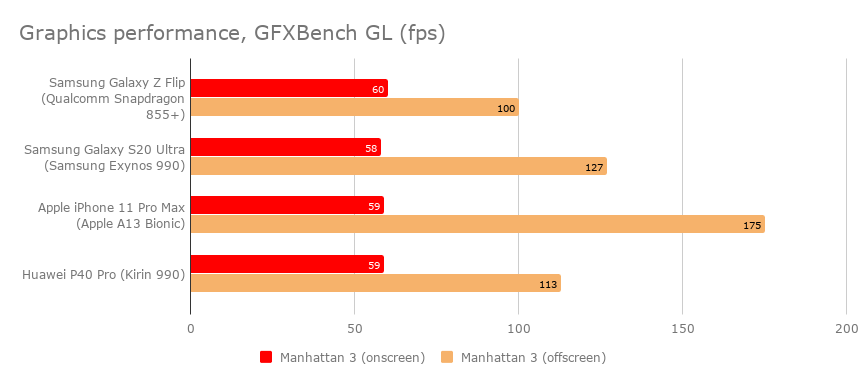
I’m quite happy with battery life too. Samsung has opted for a 3,300mAh unit and, in light use, I had no problems over a solid two days of operation. If you’re a heavyweight user, especially of such features as GPS, a single day’s life might be hard to achieve. Charging is adequate, and can be done wirelessly, of course, but the lack of fast charging hampers a quick top-up before going out to dinner in the evening.
Samsung Galaxy Z Flip review: Verdict
Coming to a conclusion about this phone is hard. Last year’s flexible offerings – whether from Huawei, Royole or Samsung – were most definitely early engineering prototypes. And the Samsung offering should never have been released, outside of a few thousand “work in progress” loan units to whet the appetites of influencers. They should not have been put on sale to the general public.
Nevertheless, with the Z Flip, things have most definitely moved forward. This is a whole generation of newer technology and lessons have been learned. It’s a wholly usable product, brimming with clever technology and capabilities. Most users would have few issues using it as a daily smartphone.
There are, however, two big “ifs”. One is known, one is unknown. First, the known: the price, at £1,300, is somewhat bold for a phone that doesn’t tick all the leading-edge boxes of 5G, Wi-Fi 6 and storage. The screen, however, makes up for that – and then some. There’s a wow factor, and truly useful aspect to the folding design, that is a breath of fresh air. I love it, and my delight hasn’t subsided yet, despite finding the screen bump and brightness wobbles.
The unknown is the reliability of the design. I know Samsung has been doing strenuous accelerated life testing, but that only gets you so far. As physicist Richard Feynman once said: “Nature cannot be fooled”. I have read that Samsung is offering one screen repair for £99. Frankly, that’s not enough reassurance for someone brave enough to spend £1,300 on such a device.
But, like the small child that I am, I still laugh out loud when I unfold the screen, and see the eye-popping reaction of my friends. That, coupled with the “good enough” specs and features, means it is good enough to be recommended to those who, like me, just love this stuff. For everyone else, wait until 2021 when the reliability has been proven, 5G and Wi-Fi 6 have arrived, and the price has halved.



